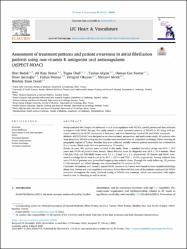Assessment of treatment patterns and patient awareness in atrial fibrillation patients using non-vitamin K antagonist oral anticoagulants (ASPECT-NOAC)

Göster/
Erişim
info:eu-repo/semantics/openAccessTarih
2022Yazar
Badak, ÖzerDemir, Ali Rıza
Önal, Tugay
Akgün, Taylan
Yontar, Osman Can
Şatıroğlu, Ömer
Duman, Hakan
Okuyan, Ertuğrul
Melek, Mehmet
Dural, İbrahim Etem
Üst veri
Tüm öğe kaydını gösterKünye
Badak, Ö., Demir, A. R., Önal, T., Akgün, T., Yontar, O. C., Şatıroğlu, Ö., Duman, H., Okuyan, E., Melek, M., & Dural, İ. E. (2022). Assessment of treatment patterns and patient awareness in atrial fibrillation patients using non-vitamin K antagonist oral anticoagulants (ASPECT-NOAC). International journal of cardiology. Heart & vasculature, 39, 100989. https://doi.org/10.1016/j.ijcha.2022.100989Özet
Background and Aim: Despite the advances in oral anticoagulation with NOACs, careful patient and dose selection is required with NOAC therapy. Our study aimed to assess treatment patterns of NOACs in AF along with patients' continuity to NOAC treatments in first year, and their knowledge level of AF and NOAC treatment.& nbsp;Methods: ASPECT-NOAC was designed as an observational, prospective, and multicenter study. AF patients who were prescribed NOACs within last four months were recruited from 34 outpatient cardiology clinics covering all geographic regions of Turkey. Baseline data were collected initially whereas patient awareness was evaluated at 3 to 4 weeks. Final study visit was performed at 12 months.& nbsp;Results: In total, 991 patients were included to the study. Mean +/- standard deviation of age was 69.4 +/- 10.2 years and 53.0% of patients were female. Mean duration from AF diagnosis was 24.9 +/- 50.9 months. Mean CHA(2)DS(2)-VASc and HAS-BLED scores were 3.1 +/- 1.5 and 1.6 +/- 1.1, respectively. AF disease and NOAC treatment knowledge levels were found to be 48.9 +/- 23.1% and 73.0 +/- 19.3%, respectively. Among reduced dose users 71.4% of patients were prescribed inappropriate reduced doses. Through the study follow-up, 32 patients (3.2%) deceased and NOAC therapy was discontinued in 74 patients (8.7%).& nbsp;Conclusion: AF patients who recently started NOAC treatment in Turkey were found to have variable knowledge about their disease and anticoagulation treatment. It was observed that most of the patients continued the NOAC treatment throughout the study. Reduced dosing of NOACs was common, which was associated with higher baseline risk for bleeding as well as stroke.

















